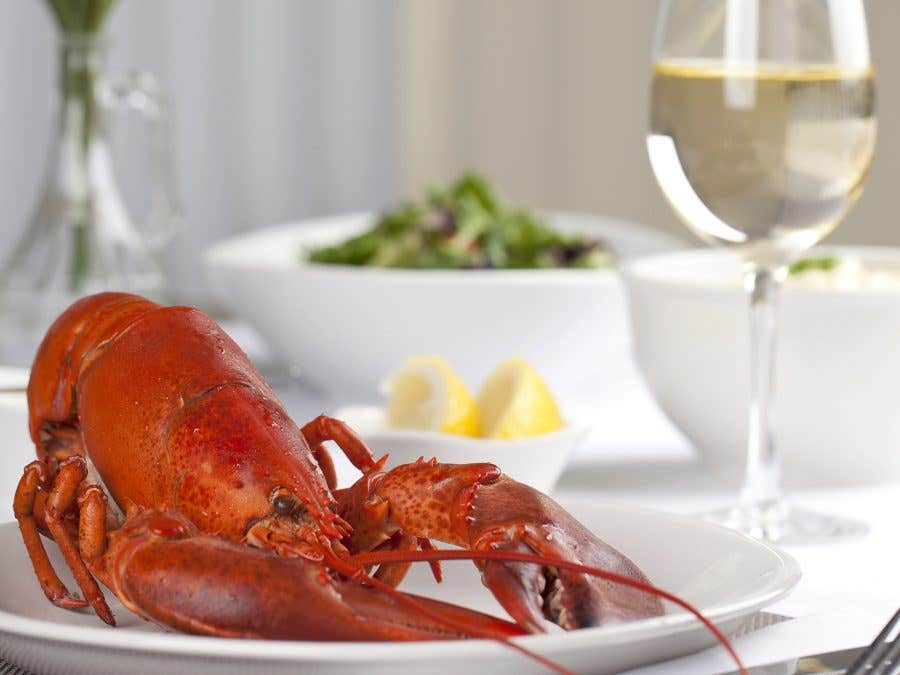You’re dreaming of the weekend and dinner on the patio, but what should you cook? Lobster season is in full swing, so why not enjoy it, and spoil yourself a little! When considering wine pairings, you have to remember that lobster has a fairly pronounced saline flavour. Females and males taste the same, though cooking times differ and the roe makes the difference for aficionados.
Team players
Contrary to general belief, lobsters are terrific team players, very versatile in the kitchen, because their sweet yet sea-salty meat accommodates any flavour. They’re delicious with fruit – mango, strawberry, apple, peach – and with foods that have a smoky or fatty umami flavour (one of the five basic tastes, together with sweet, sour, bitter and salty), such as bacon, pancetta, mushrooms, soy sauce, miso, cream, cheese, eggs or wood-smoked ingredients. They’re terrific with herbs like coriander, fennel, parsley, dill and tarragon. And they combine nicely with spices, from saffron and curry to cumin and pepper. The secret to working with lobster is to avoid overcooking, which dries out the meat. If you want a gratin or sauced dish, lobster is great with a buttery white wine. And fresh is, of course, the best.
With white wine
With their meaty texture, lobster is a gourmet treat that call for flavourful whites with a full but not excessive mouthfeel. Because of the delicate and faintly sweet taste, lobster is best paired with whites that won’t overwhelm it. "People often think Chardonnay", says sommelier Etheliya Hananova, the wine expert to Christian Bégin’s foodie on the Télé-Québec show Curieux Bégin. "The fruit texture and minerality of Chablis work with lobster, but if you served with a buttery sauce, a slightly oaked Chardonnay works better. Then again, if the dish is ultra fresh and includes, for example, fruit, Chenin Blanc is an excellent choice, as is any other smooth white with a point of acidity."
That category would include certain unoaked Bordeaux as well as wines from the Soave appellation. As for Sauvignon Blanc, avoid exuberant New World wines bursting with citrus and vegetal notes. Opt instead for a Sancerre, the Loire appellation par excellence for traditional-style Sauvignon Blanc, more restrained and possessing good minerality.
With rosé wine
Rosé wine often pairs beautifully with seafood, whose rich, meaty texture calls for a chilled rosé from Sancerre or Provence. “I love rosés made with Pinot Noir because they have a fresh, naturally delicate taste,” said Etheliya Hananova. That freshness is often what’s missing from heavier rosés, like those made with Grenache grapes.
Quebec rosés really bring out the flavour of lobster. Made from European or hybrid grapes, they all feature the one thing that makes them simply divine with shellfish: acidity. And it’s all thanks to the local climate! These rosés are typically blended wines. Some have tart or spicy notes, but they’re all perfectly elegant. Give them a try!
With red wine
It’s unusual but not unheard of to uncork a red with lobster or crab – depending on the dish. Véronique Rivest, renowned sommelier, notes that while anything is possible with whites (led by Champagne), red-wine pairings are more complicated, especially with plain lobster. “Lobster brings out the bitterness and astringency in wine,” she explains. “Even low-tannin wines aren’t always suitable.” But take heart, red-wine buffs: Combine lobster or crab with the appropriate ingredients and they can indeed be paired with reds.
Crustaceans 101
The size of a lobster does not affect its taste or texture, so let your appetite dictate what weight to pick. Note, however, that lobsters of at least 700 g (1 1/2 lbs) provide optimal meat-to-shell ratio. Live lobster, covered with a damp cloth (rather than in water), will keep in the refrigerator for up to two days. To cook, steam over 5 cm (2 in) of salted water or immerse in highly salted water for 12 minutes per 500 g (1 lb). Don’t discard the shells as they can be used to make a delicious court bouillon. Lobsters available here in the off-season are from lobster pounds in the Maritimes or Maine, whose seasons are much longer than Quebec’s.
 Free in-store delivery with purchases of $75+ in an estimated 3 to 5 business days.
Free in-store delivery with purchases of $75+ in an estimated 3 to 5 business days.










